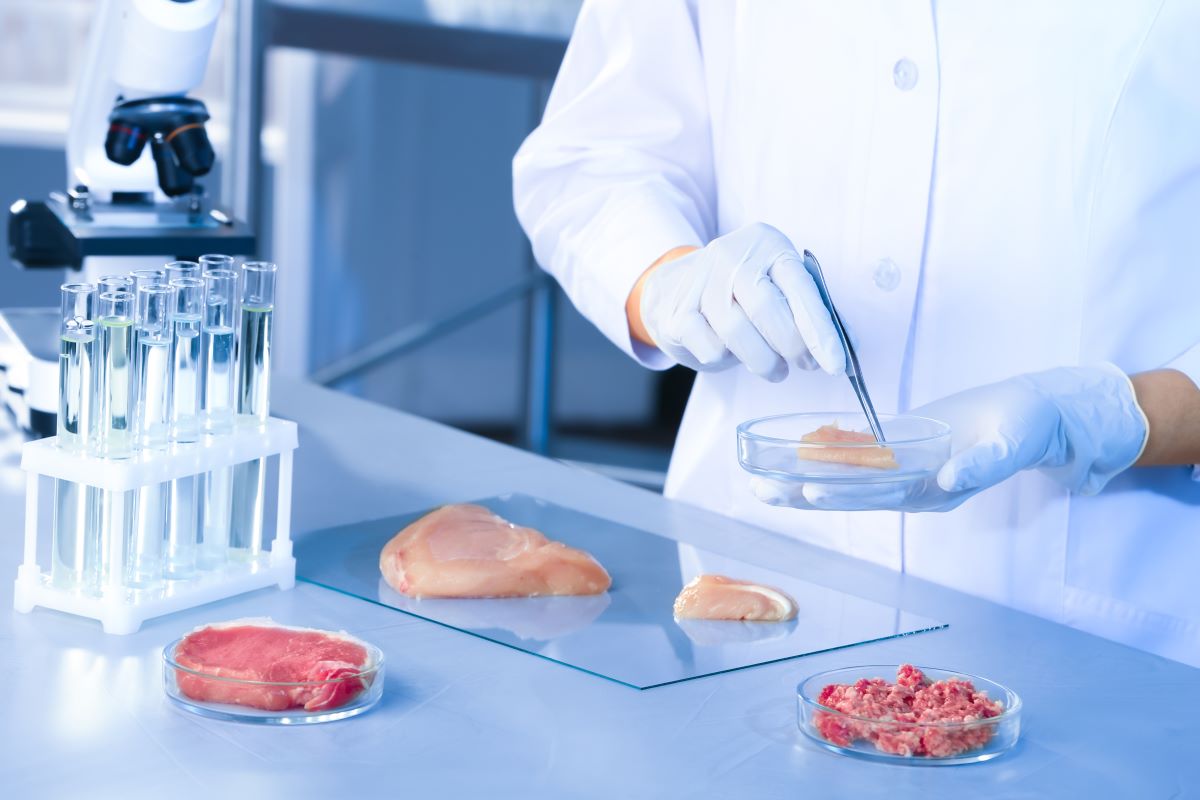5 Companies Leading the Charge on Alternative Protein

Consumers are more aware that what they put in their bodies impacts how they feel. As a result, the concept of personalized nutrition has staying power for the long term and became especially important during the coronavirus pandemic when people began seeking ways to take better care of their bodies.
Since the outbreak of COVID-19, Mintel’s Better for You Eating Trends, US (Nov. 2020) reports 37% of U.S. consumers have prioritized healthy eating, 47% changed the type of basic groceries they buy and 64% selected more nutrient-dense foods. These dietary changes and a focus on healthier living resulted in the explosion of the plant-based foods category. Today, nearly half of all consumers say they are choosing these alternatives now more than they did a year ago.
Plant-based food sales in 2020 grew two times faster than overall food sales. Alternative meat saw a 45% increase from 2019 to 2020, reaching $1.4 billion in sales last year. The total U.S. plant-based market is worth $7 billion and continues to trend upwards thanks to market demand and innovation bringing greater variety. In the future, we will see advancements made in the production process which will allow new plant-based proteins to be used for new product development.
What is Cell-Cultured Meat?
Cell-cultured meat, also known as cultivated, cell-based or lab-grown meat, is animal meat and seafood produced by cultivating animal cells directly. Cell-cultured meat and seafood could be a valuable alternative to tackle climate change because it eliminates the need to raise and farm animals for food and is also good for animal welfare and human health.
In May, Green Queen cited new research out of Arizona State University that claims consumers believe cultivated protein could make up as much as 40% of their future meat intake with conventional meat making up the other 60%. Surveying more than 2,000 U.S. consumers and 2,000 UK consumers, the study found generation Z was the most open to trying cell-based meat with 88% saying they would welcome them. Millennials followed closely at 76%.
The research suggests cell-cultured meat is likely to be accepted by the public, especially the younger generations.
What Will Cultivated Meat Taste Like?
According to the Good Food Institute, cultivated meat is made from cell culture techniques that replicate the sensory and nutritional profiles of conventional meat. However, the final product prepared using these cells requires additives to resemble the color, texture and taste of traditional meat. That’s where Synergy Aromas will come in – once cell-based meat receives regulatory approval in the U.S.
Synergy Aromas has been working in the plant-based category since 2003, specializing in providing authentic meat and savory flavors suitable for vegan products. Our technical team has extensive experience in developing customized solutions for unique substrates and process parameters, ensuring high-quality taste solutions across plant-based products.
Schedule a call with your Synergy Aromas representative to be further guided through the plant-based flavoring process and to learn how we can help your meat alternative taste amazing!
Regulatory Approval
The question on everyone’s mind is: When will the U.S. approve cell-cultured meat? Early reports indicated industry experts believed approval could happen later this year, but it looks like it will take longer than that.
Dr. Harini Venkataraman, Ph.D., analyst at Lux Research and author of “How Will Cell-Based Meat Be Regulated? An Overview of the Current Global Regulatory Landscape,” said Singapore’s approval of cell-based meat opened the door for other countries to consider it and look at the commercial opportunity.
In December, Eat Just received regulatory approval to produce and sell cell-cultured meat in Singapore. The San Francisco, Calif.-based plant-based alternatives company became the first in the world to sell cell-based meat.
While Venkataraman sounds optimistic that other countries including the U.S. will follow suit, Forbes contributor Brian Kateman is a bit more skeptical and critical of the country’s lack of progress on this front. He wrote in April that the “U.S. regulatory process for cell-based meat is inhibiting us from making the progress Singapore is making today. This is a massive missed opportunity for a nation that prides itself on being a leader in innovation.”
So where is the U.S. in the regulatory process today? A joint agreement was established in 2019 that declared the USDA and FDA will co-regulate all cell-based products except for seafood, which will fall solely under the FDA’s jurisdiction. Fast-forward two years and there are still no cell-cultured meat products in the U.S. market, which is where Kateman’s judgment comes in.
“Two years on with still no products on the American market, it’s clear that cell-cultured meat is being held to a higher safety standard than most food products,” Kateman writes. “Food safety is of critical importance – I’m not arguing for throwing caution to the wind. But unlike conventional meat, cell-cultured meat is made in sterile environments, with a demonstrably low incidence of microbials and few if any antibiotics are required. And yet, it’s developers continue to wait with their hands tied for the U.S. government to give them the green light.”
Venkataraman said the U.S. has been one of the leading countries thinking about cell-based regulation and could be one of the next countries to grant approval, especially for seafood. “Because it falls solely under the FDA, and because we’ve seen some developments from companies like BlueNalu in terms of getting cell-based seafood to market, I imagine seafood regulation may be faster than beef and some of the other types of products we’re looking at,” he explains.
While we wait for the U.S. government to take the next steps in cell-cultured meat, more companies are leading the charge in research and development.
5 Companies Leading the Charge on Alternative Proteins
Over the past five years, the cell-based meat industry has grown from a handful of startups to 80 companies that are developing end products or working on specific technology challenges. Since 2016, more than $800 million has been invested in the space.
Here is a look at five companies laying the groundwork for the future of cell-based meat.
Mosa Meat
Food technology company Mosa Meat was founded in 2013 by Dr. Mark Post, who at the time cooked and tasted the world’s first cell-cultured hamburger in London. The company’s mission is to “pioneer a cleaner, kinder way of making beef.”
The company says it chooses the “healthiest cows and the best cells to help us grow our meat.” Once a sample of cells are collected, which Mosa Meat says are the size of a peppercorn, the cows are sent back out to roam in the fields. “Natural food and a natural environment helps (livestock) grow strong – so that’s exactly what we provide for our cells,” the company explains. “Lots of nutrients, vitamins, a comfy climate and fresh air.”
Mosa Meat projects it can grow a “beef” patty for about $10.62 and is focused on scaling up its production process and getting its first products on the market in the next three to four years, according to reports.
Upside Foods
Formerly known as Memphis Meats, Berkeley, Calif.-based Upside Foods uses myosatellite cells like Mosa Meat to grow meat products. The company produced the world’s first cultured beef meatball in 2016 and the first cultured chicken and duck in 2017.
In January 2020, Upside Foods raised $161 million and attracted investors like Bill Gates and Richard Branson. The company used the funds to set up a pilot production facility and hopes to share its products with consumers by the end of 2021. The company’s first target market is the U.S., but it has global ambitions.
BlueNalu Inc.
San Diego, Calif.-based BlueNalu is developing seafood products from fish cells using cellular aquaculture, which means living cells are isolated from fish tissue, placed into culture media for proliferation and then assembled into fresh and frozen seafood products. The company is focusing on finfish, including mahi-mahi, red snapper, tuna and yellowtail.
Griffith Foods announced its investment in BlueNalu last year and said its strategic partnership includes providing product development expertise, especially in food science, culinary arts, market insights and sensory optimization.
In June 2020, BlueNalu announced the development of a new facility in San Diego that is more than 38,000 square feet and at the time said the company planned to launch its products in the second half of 2021.
Wildtype
Wildtype is a start-up innovating in cell-based techniques to produce seafood alternatives, specifically cultured salmon. Founded in 2016, Wildtype recently announced its San Francisco-based pilot plant is now operational. The company gives the public an inside look at the new facility through renderings rather than photos that could jeopardize its proprietary equipment and instrumentation.
The company produces its sushi-grade salmon by starting with living cells from Pacific salmon. Its cultivation system creates the same conditions as those within a wild fish, including the right temperature, pH, nutrients and other conditions that enable the cells to grow and mature as they would in the wild. Wildtype then harvests the cells from the cultivators and “seed them into plant-based structures, where they are guided to become the cuts of salmon that we love.”
The company has a pending patent that covers a tissue culture method to produce fish muscle tissues and fat cells using a non-serum media formulation in pathogen-free culture conditions without exposure to toxins and other undesirable chemicals. The method is used to produce cultured food products including sushi-grade fish meat, fish surimi and foie gras.
Finless Foods
Finless Foods, based in Emeryville, Calif., is a start-up focused on developing cultured bluefin tuna, which is an expensive and endangered animal that can’t be farmed using aquaculture. In June, the company announced it would soon launch its plant-based tuna which is made from nine whole, plant-based ingredients that are cooked and seasoned to mimic the taste and texture of tuna. The product was designed to act as a substitute for raw tuna for poke and spicy tuna rolls.
In terms of its cell-based efforts, Finless Foods said it has “blown past all of our milestones this year already and we just broke ground about a month ago on our pilot facility.” While Finless Foods is not releasing its ingredient list because the product won’t launch until next year, co-founder Mike Selden said the company is using nine whole vegetable ingredients and the base is in the melon family. The company is also focusing on getting omegas rather than protein into its products because that’s why consumers buy seafood.
We can expect to see ground and process plant-based products from burgers to crab cakes from Finless Foods while its cell-cultured products will more closely replicate whole cuts. “I don’t think plants are fantastic at creating whole muscle, and for something like sashimi, I think that’s really where the cell-cultured technology comes in, which is why we’re still developing that, because it’s a huge chunk of the market,” Selden said.
insights

